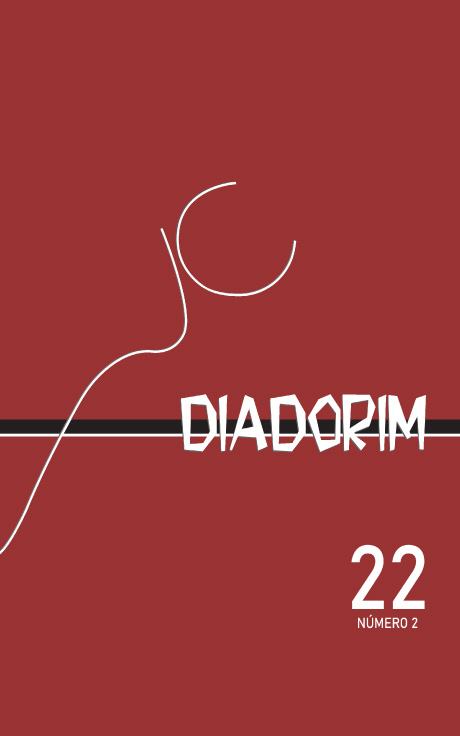O Sistema Responsivo do Português Brasileiro
DOI:
https://doi.org/10.35520/diadorim.2020.v22n2a32800Palavras-chave:
fragmento de resposta, polaridade, negação, português brasileiroResumo
Uma diferença marcante entre as línguas diz respeito à forma com que perguntas sim-não são respondidas: com partículas em francês, verbos-eco em irlandês e pela combinação de partículas e verbos-eco no Português. Essa distinção tem recentemente atraído a atenção da área da Teoria Gerativa. Holmberg (2013, 2016), por exemplo, afirma que a sintaxe das respostas a perguntas sim-não é em grande parte similar à sintaxe das perguntas. De acordo com o autor, a distinção tipológica entre sistemas baseados na verdade e sistemas baseados na polaridade está relacionada à posição que a negação ocupa; língua com um consistente sistema baseado em polaridade só apresentam negação média ou alta, enquanto línguas com um sistema baseado em verdade só apresentam negação baixa. Há ainda línguas como o inglês, que apresentam variação entre negação alta e baixa. O objetivo deste artigo é discutir qual o tipo de sistema responsivo do português brasileiro (PB), considerando que o PB apresenta três tipos de negação, dependendo do número e posição de itens negativos na sentença – Neg VP; Neg VP Neg e VP Neg.
Referências
BIBERAUER, T.; CYRINO, S. Appearances are deceptive: Jespersen’s Cycle from the perspective of the Romania Nova and Romance-based Creoles, paper presented at Going Romance 23, University of Nice, Nice, 2009.
BORSLEY, R; JONES, R. Welsh negation and Grammatical Theory. Cartiff: University of Wales Press, 2005.
FARKAS, D.; BRUCE, K. On reacting to assertions and polar questions. Journal of Semantics v. 27, p. 81-118, 2010.
HOLMBERG, A. The syntax of yes and no. Oxford: Oxford University Press, 2016.
______. The syntax of answers to polar questions in English and Swedish. Lingua,v.128. Special Issue: Polarity emphasis: Distribution and locus of licensing, p. 31-50, 2013
JONES, B. M. The Welsh answering system. Moton de Gruyter, 1999.
KATO, M.A.; TARALLO, F. Sim: respondendo afirmativamente em português. . In PASCHOAL, M.S.Z.; CELANI, M.A.A. (eds). Linguística Aplicada: da Aplicação da Lingüística para uma Lingüística Transdisciplinar. São Paulo: EDUC, pp. 259.278, 1992.
KATO, M.A. Minimal answers and IP-remnanent movement. 2010 (apresentação oral)
KATO, M.A.; CYRINO, S. Minimal answers in Brazilian Portuguese. 2012 (apresentação oral)
KRAMER, R.; RAWLINS, K. An ellipsis approach to answer particles in positive and negative contexts, 2012.
KUNO, S. The structure of the Japanese language. Cambridge, MA: Massachusetts Institute of Tecnology,1973.
LAKA, I. On the syntax of Negation. New York: Garland, 1994.
MARTINS, A. M. Emphatic polarity in European Portuguese and beyond. Lingua, v.128, p. 95-123, 2013.
OLIVEIRA, M. Frases assertivas e suas variações nas línguas românicas: o seu papel na aquisição. São Paulo: Humanitas, 2000.
POPE, E. N. Questions and answers in English. The Hague/Paris: Mouton, 1976.
RIZZI, L. The fine structure of left periphery. InHaegeman, L. (ed). Elements of Grammar, p. 281-337, Kluwer Academic Puplishers, 1997.
TEIXEIRA DE SOUSA, L. Sintaxe e interpretação de negativas sentenciais no Português Brasileiro. Tese (DoutoradoemLinguística), Unicamp, 2012.
______. Three types of negation in Brazilian Portuguese.Lingua, v. 159, p. 27-46, 2015.
WALKER, M. Inferring acceptance and rejection in dialogue by default rules of inference. Language and Speech, v.32, n.2, p. 39-2, 1996.
Downloads
Publicado
Edição
Seção
Licença
Transferência de direitos autorais - Autorização para publicação
Caso o artigo submetido seja aprovado para publicação, já fica acordado que o autor autoriza a UFRJ a reproduzi-lo e publicá-lo na Diadorim: Revista de Estudos Linguísticos e Literários, entendendo-se os termos "reprodução" e "publicação" conforme definição respectivamente dos incisos VI e I do artigo 5° da Lei 9610/98. O artigo poderá ser acessado pela internet, a título gratuito, para consulta e reprodução de exemplar do artigo para uso próprio de quem a consulta. Essa autorização de publicação não tem limitação de tempo, ficando a UFRJ responsável pela manutenção da identificação do autor do artigo.

A Revista Diadorim utiliza uma Licença Creative Commons Atribuição-NãoComercial 4.0 Internacional (CC BY-NC 4.0).

